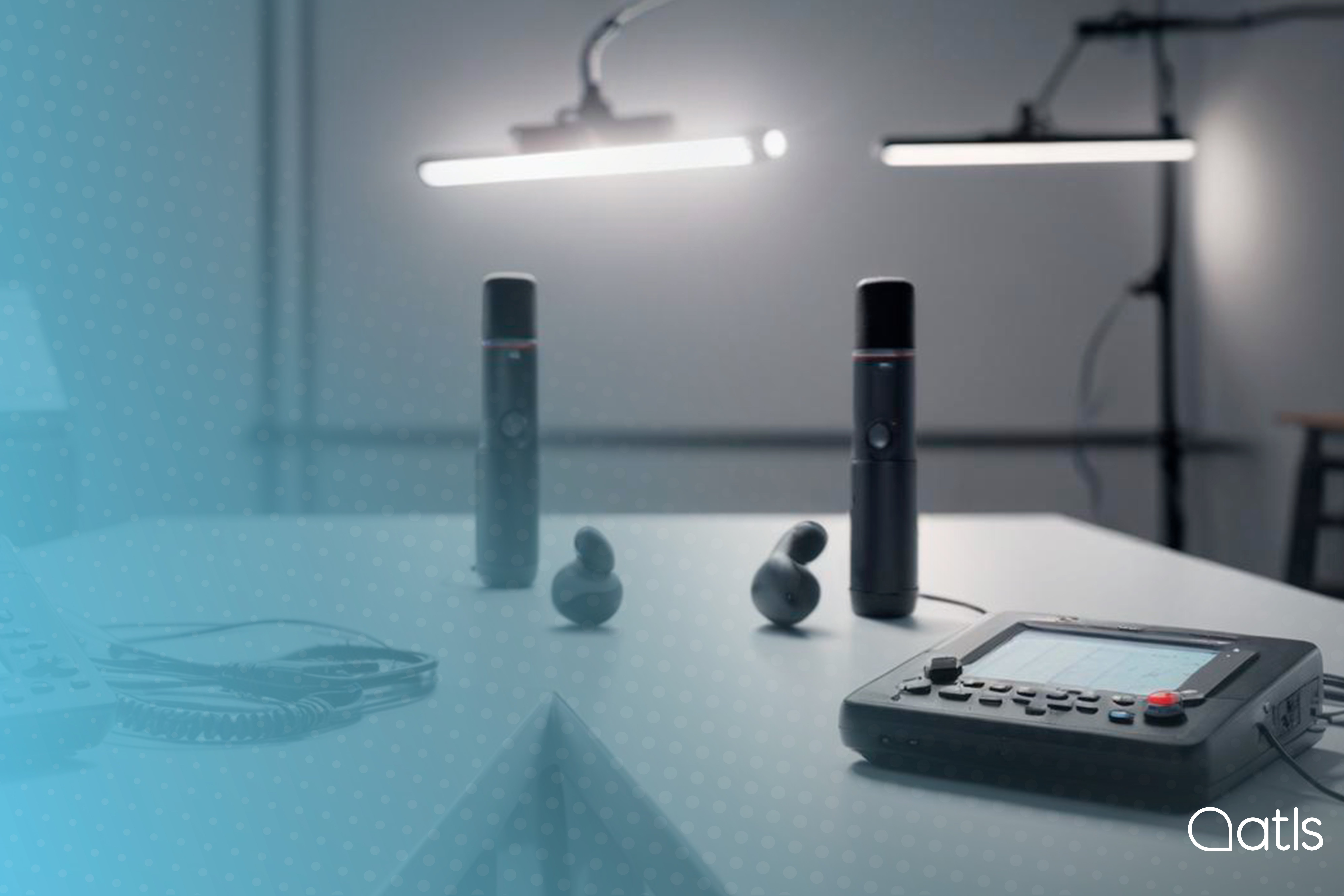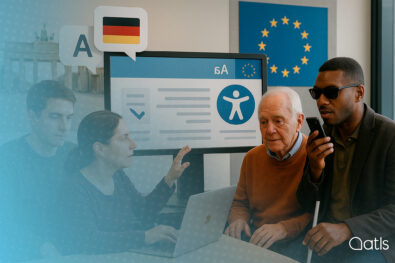In interpreting, technology has completely transformed the way oral translations are performed in real time, enabling multilingual communication in increasingly diverse and discerning environments.
This evolution means that today we have various solutions tailored to all types of events and needs. Two of the most commonly used options are Infoport, a portable and flexible system, and the traditional technical setup for simultaneous interpreting, recognised for its precision and quality in large-scale events.
Although both systems share the same objective, namely allowing participants to understand a speech in their language immediately, the differences in infrastructure, cost, logistics and user experience are significant.
So it is essential to grasp how each one works and in which settings it is most appropriate so you can take the best decision based on the type of event, the number of attendees, the environment and the available budget.
What is Infoport and how does it work?

Infoport is a portable, wireless simultaneous interpreting system specially designed to enable multilingual communication in situations where mobility, quick deployment and technical simplicity are priorities.
This system consists of a wireless transmitter used by the interpreter to broadcast the translation in real time plus individual receivers worn by the attendees who listen to the interpretation through headphones.
Unlike traditional systems, Infoport does not require soundproofed booths or technical consoles. Its simple and efficient operation makes it an ideal choice for guided tours, audits, inspections, on-site training or small meetings. Participants can move freely around the space without losing the thread of the speech.
Furthermore, its lightness, autonomy and ease of use allow the system to be up and running in a matter of minutes with no need for specialised technical personnel. In a nutshell, Infoport is a practical, functional and cost-effective solution for events with few attendees which require clear interpreting free of technical hassles.
Infoport's advantages:
✅ Mobility and flexibility: ideal for guided tours, audits, on-site training and work meetings.
✅ Fast assembly: no installation or specialist technical staff required.
✅ More affordable cost: eliminates the need to rent bulky equipment or soundproofed booths.
✅ Interaction is made easier: allows participants to be on the go without missing out on the translation.
✅ Use in dynamic environments: ideal for situations where participants need to move around during the event while maintaining clear reception of the interpretation.
How does traditional simultaneous interpreting work?
Traditional simultaneous interpreting is the most widely used system for large-scale events such as congresses, international conferences and institutional meetings. This model is based on a package of technical and human components that ensure accurate, seamless and premium quality communication in real time.
The process takes place in soundproofed booths where professional interpreters work with microphones, interpreter consoles and headsets isolated from outside noise so that they can fully concentrate on the original speech. While the speaker is talking, the interpreters translate simultaneously into the required language with only a few seconds delay.
The interpreting is relayed to the audience via a system of wireless receivers and individual headsets, allowing each attendee to follow the event's content in their own language with no interruptions or interference. This system is designed to deliver the highest sound quality, terminology accuracy and reliability even in multilingual settings and with lots of participants.

Its ability to handle several languages at once and its outstanding professionalism make this type of interpretation the go-to solution in environments that call for rigour, protocol and communicative excellence.
Advantages of the traditional system:
🔹 Superior sound quality: soundproofing allows interpreters to work without external distractions.
🔹 Ideal for multi-language events: congresses, international conferences and diplomatic meetings all require this system.
🔹 Greater comfort for interpreters: an ergonomic environment helps maintain concentration during long sessions.
🔹 It allows for more accurate translation: by minimising external noise, interpreters can focus on delivering seamless and accurate interpretation.
🔹 Scalability: it can be adapted to events with hundreds or thousands of attendees without compromising quality.
Differences between Infoport and simultaneous interpreting
When choosing between Infoport and traditional simultaneous interpreting, it is essential to assess a number of factors that will make the difference in the event's communicative experience. The most relevant aspects to be taken into account are:

Size and type of event
Infoport is the most suitable option for small groups, dynamic meetings or events that call for continuous movement of participants. By contrast, traditional simultaneous interpreting is designed for conferences, congresses, institutional events and meetings with numerous attendees where a robust technical infrastructure and the ability to handle multiple languages simultaneously is a must.
Technical infrastructure
Infoport stands out for its simplicity and portability as it does not require soundproofed booths or technical staff to set it up. The system can be up and running in a matter of minutes. In contrast, the traditional simultaneous interpreting option needs more complex facilities including booths, consoles, receivers and specialised technicians, which means more planning and preparation time.
Sound quality
In settings where sound quality is a priority, traditional simultaneous interpreting has a clear edge. Booth soundproofing and using professional equipment ensures crystal-clear transmission, free from external noise and interference. Infoport, by contrast, is exposed to the surroundings and can be adversely affected by ambient noise, especially in large or poorly acoustically-controlled spaces.
Cost and logistics
Infoport is a more affordable and practical solution as it significantly cuts rental, transport and assembly costs. Meanwhile, traditional interpreting involves greater outlay in both technical and human resources yet also furnishes higher levels of specialisation and professionalism.
Flexibility and mobility
Infoport enables complete mobility as it does not restrict the space or arrangement of the participants. It is ideal for events where freedom of movement is essential without losing the connection with the interpreter. By contrast, traditional simultaneous interpreting is designed for more structured and static settings where attendees stay in a fixed place for the entire session.
Which one to choose?
The choice between Infoport and traditional simultaneous interpreting will depend largely on the type of event, its logistical features and communication goals.
If you are looking for a cost-effective, flexible and easy-to-implement solution, especially for dynamic environments with small groups, Infoport is a practical and efficient option. However, if the event calls for the highest sound quality, handling several languages at the same time and a thoroughly professional environment, traditional simultaneous interpreting is the most robust and reliable choice.
Both systems are valid and effective, but they meet different needs. So it is essential to carefully consider the context of the event, the number of participants, the technical requirements and the significance of seamless and accurate communication to pick the option that will deliver the best outcomes.
Are you looking for an interpreting service for your event?

At ATLS we help you break down language barriers with custom-designed interpreting solutions. Whether using Infoport systems, ideal for dynamic meetings and more flexible formats, or with traditional simultaneous interpreting, perfect for congresses, conferences and large-scale events, we have the technology and the team to ensure smooth, accurate and professional communication.
Get in touch with us and we will be happy to advise you personally about the most appropriate option for your type of event, language, format and budget.
Choose us to bring you a seamless multilingual experience.
FAQs about the difference between Infoport and traditional simultaneous interpreting
What are the differences between Infoport and traditional simultaneous interpreting?
Infoport is a portable system without soundproofed booths, ideal for small meetings, guided tours or audits, whereas traditional simultaneous interpreting needs booths and advanced technical equipment, making it the better option for conferences and large events.
When is it best to use Infoport instead of traditional interpreting?
Infoport is recommended for events where attendees need to be on the move such as factory tours, audits or on-site training. Conversely, traditional simultaneous interpreting is ideal for large events with multiple languages calling for high quality audio.
How much does it cost to hire a simultaneous interpreting service?
The price varies based on the type of interpreting, the length of the event and the setup required. Generally speaking, Infoport is more budget-friendly whereas traditional simultaneous interpreting entails higher costs due to its technical equipment and specialised interpreters.
How can I hire an interpreting service for my event?
At ATLS we provide bespoke solutions for any type of event. Feel free to contact us for advice and a no-obligation quote. You can email us at [email protected] or visit our website atls-global.com.






